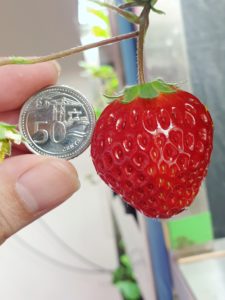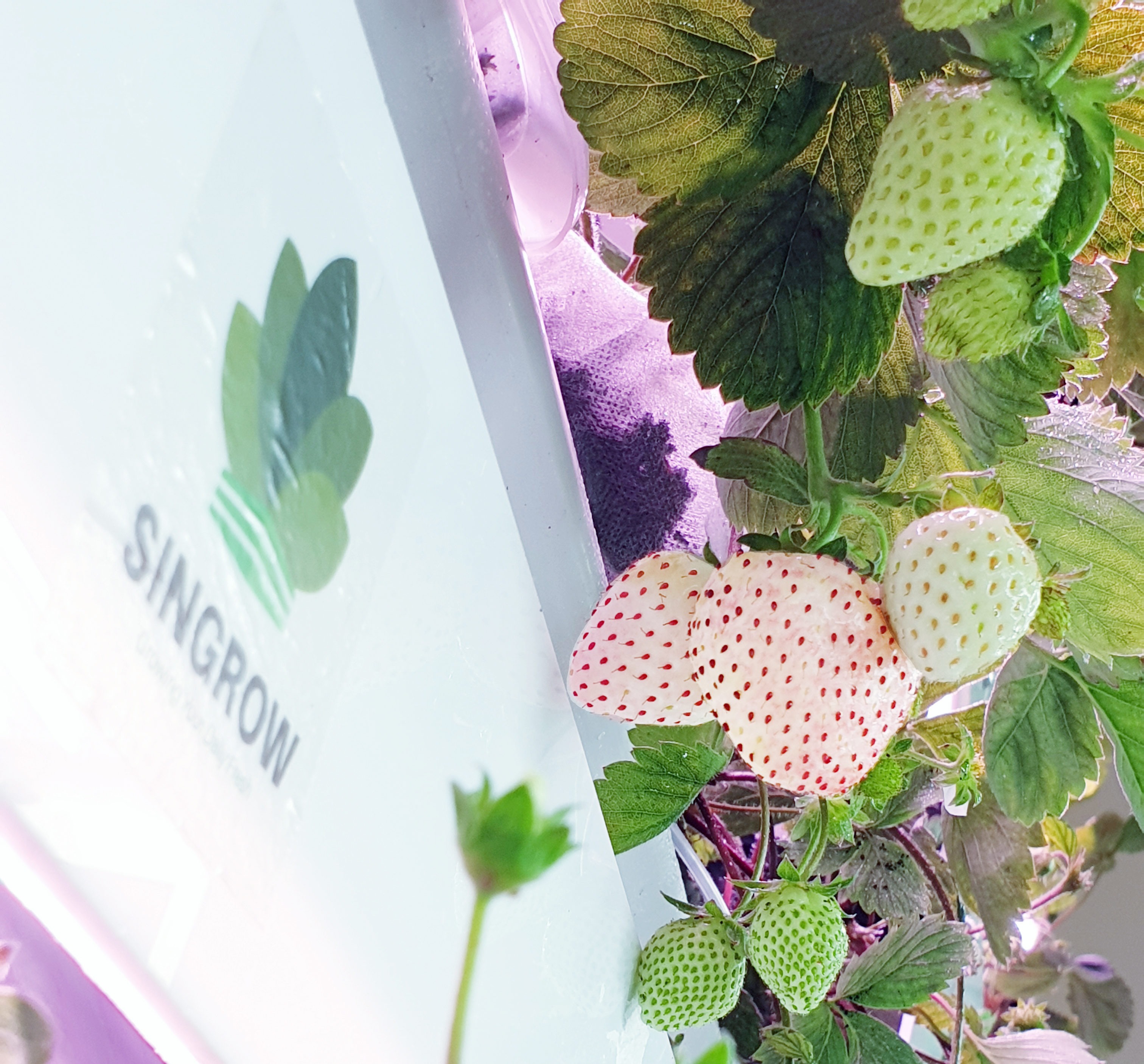I live in sunny Singapore. It’s the twentieth smallest country in the world, with a land area of just over 700 square kilometres. Land is scarce, and with nearly six million mouths to feed, it’s impossible to feed just about everyone. That’s why the city state imports a whopping 90% of its food, according to the Singapore Food Agency (SFA). Only a small amount is produced locally – 8% of vegetables, 8% of fish and 26% of eggs.
And here’s my problem with some of the food: it’s not very good. Especially the strawberries. The ones that make it to Singapore’s shores hail from Japan, South Korea, Australia, the US, and Canada. And they either taste of water, or they’re really good and they cost too much.
“When I moved to Singapore, I found that sadly, the strawberries one can buy from the supermarket are nothing close to those I’ve been eating for years,” recounts Singrow founder, Bao Shengjie, of his childhood in China.”Just like every other kid, I couldn’t keep my hands off strawberries. And I want to bring that same enjoyment of a good strawberry, to everyone in Singapore.”
(While I’m sitting across Xu Tao and fellow co-founder Bao Shengjie, I’m glaring at a receipt from a Japanese grocer that sold me a punnet of six strawberries for S$15. That works out to S$2.50 (US$1.8) per berry. Ridiculous.)
But SinGrow gave me hope. Sitting at one of their first practice pitches as they prepped for the Grow Accelerator’s “Meet the Cohort” event, I nearly teared up. I foresaw a future, where every Singaporean (or any of our six million inhabitants) could gain access to a sweet, reasonably-priced strawberry. (Yes, I do love strawberries!)
And here’s how SinGrow’s founders Bao Shengjie and Xu Tao pass on the savings to consumers – they grow the berries locally.

Guess what – SinGrow’s product will be better for the environment. As most imported food is air-flown, the carbon footprint of each punnet of strawberries is significantly higher than locally grown indoor strawberries. Imported food generally contains more packaging as well – think boxes, bubble wrap, labels, and stickers.
So – what’s SinGrow’s origin story and how does its tech work? AFN finds out.
Joe Gan: Tell us what inspired you to come up with your solution?
Bao Shengjie: I grew up in Ningbo, Zhejiang, China, a coastal city in Eastern China close to Shanghai. Just like every other kid in the city, I couldn’t keep my hands off strawberries. I fondly recall a spring outing organized by my elementary school – a visit to the local strawberry farm, which gave us the chance to feast on fresh berries picked ourselves, off the vine. The ambient temperature was around 5℃ outdoor and 20℃ inside the strawberry greenhouse farm. I remember everyone breaking out in a sweat after bending over constantly for more than 5 minutes to fill our mouths with the fruit (as it’s wintertime, we pile on a lot of layers). But the taste of fresh sweet strawberries totally rewarded our hard work.
When I moved to Singapore, I found that sadly, the strawberries one can buy from the supermarket are nothing close to those I had been eating for years. That’s what sparked my study into the problem of Singapore’s local strawberry market and to explore ways that I could devote my knowledge in plant physiology and molecular biology into its urban farming industry.

What makes your tech and product better than others?
Unlike the majority of local urban farming companies, SinGrow is the only company founded by plant scientists and aims to address market needs from the plant biology aspect. Our key strength is the deep understanding of genetic and environmental regulation of plant flowering. In other words, we have the know-how to make almost every angiosperm species to flower in a designed way. Our cofounder, Professor Yu Hao, has been working in this field for more than two decades and has published more than 80 peer-reviewed research articles.
As for getting into strawberries, it had already been a hobby of mine since 2016. I obtained seeds of two natural mutants of a red strawberry species that produce whitish fruits. At that time, the white garden strawberry was just introduced to the market at a very high price. I then wondered if I could use these good mutant materials to generate my own white strawberry variety. I brought the seeds to Singapore and started the cross-breeding process in Professor Yu Hao’s lab.
It took me three years to complete six-generations of cross-breeding and selection to finalize our current Crystal strawberry. I also started to design and optimize indoor strawberry farming technology together with Xu Tao, from early 2018. We built up our first hand-made strawberry hydroponic system in the lab and tested several different hydroponic techniques. Compared to other conventional hydroponic techniques and setups, our current prototype design is much better at giving the plant the support it needs to produce fruit, which is superior in terms of both quality and quantity.
What’s next for you?
We just finished our first hiring and will welcome our new Business Development Director in October 2019. He has ten-years experience in global business development from Enterprise Singapore.
We have also confirmed our collaborations with two partners for our farming facility, the contractor of the Henderson Secondary School (GWS Living Art & City Sprouts, we were introduced to them by the Singapore Food Agency and the system solution provider of our large-scale hydroponic facilities. Once GWS is done with the Henderson Secondary School renovation, SinGrow will start to set up the vertical farms.
We aim to start work on the inner renovation of the farm by December 2019. By February 2020, we have our eyes on completing the vertical farm set-up and we’ll start to transplant strawberry plants from our nursery to the new facility. By April 2020, we will send out sample produce for marketing and certification. You can’t miss that.
Joe: I’ll be reviewing SinGrow’s strawberries in AFN’s latest column – What the Fork? Stay tuned for that.
Check out my previous AFN Introduces… where I get up close and personal with the founders of Viridis RS and Tractorjunction.com – also from the latest GROW accelerator cohort.




